What Is Gluten? The Science Behind Great Dough
A primer on how wheat protein enhances doughs, batters, and baked goods of all kinds (and what "gluten-free" actually means).
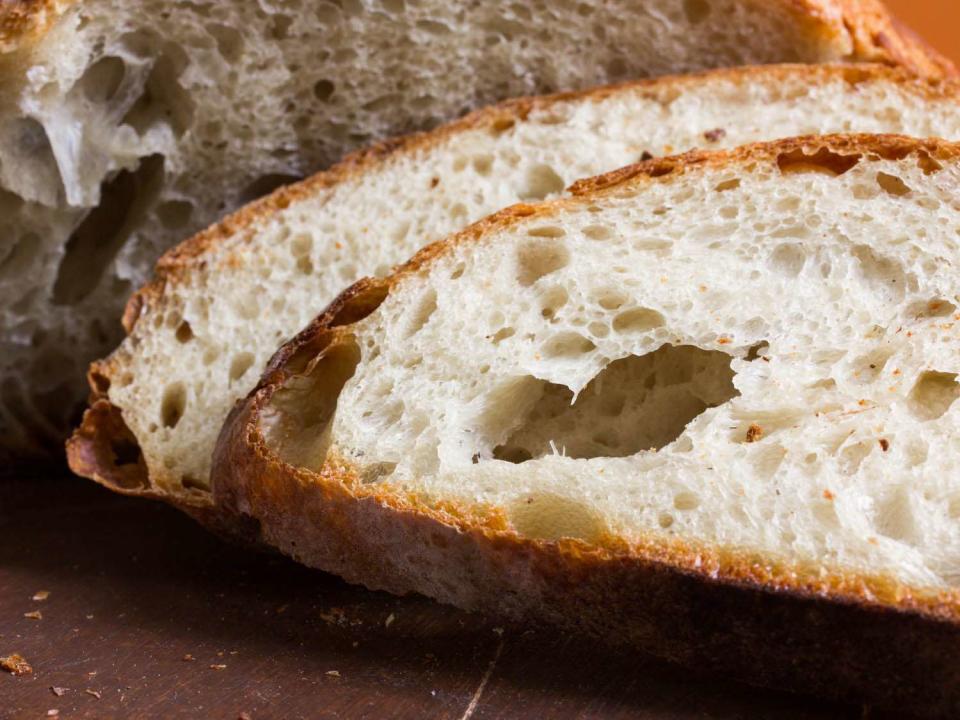
Serious Eats / Vicky Wasik
Gluten-free substitutes for bread, pasta, pizza, and pastries have come a long way in recent years—which is great news for those who are gluten intolerant or have celiac disease. But whether you’re a gluten fanatic or avoid it like the plague, it’s important to acknowledge that the success of these gluten-free facsimiles depends on how well they imitate the structure and texture that gluten imparts to doughs, batters, noodles, and all kinds of baked goods.
So what is it that makes gluten so hard to replicate, and how does it work?
What Is Gluten, Anyway?

Gluten is a stretchy, springy network of protein molecules that gives ramen noodles bounce, pizza crusts a chewy texture, and bread its interior structure. Gluten formation is often summed up in a simple formula—Flour + Water + Mixing = Gluten—but in truth, it’s slightly more complex: Gluten forms when the flour of certain grains is mixed with water in a certain way.
In order to fully understand gluten, it helps to have a little background on flour. All flours are milled from grains,* which are actually seeds composed of three distinct, edible parts. The bran is the grain’s protective, fibrous outer skin; the germ is the seed’s embryo, or the part that would sprout into a new plant; and the endosperm is the germ’s delicious, starchy food supply. If you feel like nerding out, you can get an in-depth explanation of grain anatomy in our guide to whole grains, but the important thing to know here is that the endosperm of certain grains—namely wheat, barley, and rye—contains a pair of proteins called glutenin and gliadin, which are the building blocks of gluten.
Flours that contain glutenin and gliadin are said to be "glutenous" or have "gluten potential." Flours that don’t contain that pair of proteins—think rice flour, corn flour, buckwheat flour, and so forth—get labeled gluten-free. (Gluten-free flours typically require stabilizers and thickeners like xanthan gum, guar gum, or eggs to produce comparable textures in gluten-free baked goods.)
*This doesn’t include ground products that are labeled flour, such as coconut flour, almond flour, and the like.
Two things happen when you add water to a glutenous flour: Starch molecules in the flour expand, and glutenin molecules team up to form long, curly chains that bond with one another.
Mixing, kneading, and long periods of rest all encourage these bonds in dough, giving it what it needs to stretch and spring back—a quality we call elasticity. However, we can’t rely on glutenin alone; if we did, we’d be constantly fighting with dough that resists any attempt to be shaped into loaves. This is where gliadin comes in handy.

Gliadin molecules remain in their compact shape in the presence of water. This, says food scientist Harold McGee (in his seminal On Food and Cooking) means they "act something like ball bearings, allowing portions of the glutenins to slide past each other without bonding." This behavior contributes to the dough’s extensibility—its ability to be shaped and to sustain its shape during cooking or baking.
Together, that dynamic duo of glutenin and gliadin give dough its viscoelastic properties—otherwise known as the ability to be simultaneously stretched out and shaped. Initially, though, these two proteins aren’t interacting in a very organized way.
In Bread Illustrated: A Step-By-Step Guide to Achieving Bakery-Quality Results at Home, the cooks at America’s Test Kitchen imagined these proteins as tangled balls of string "that need to be unwound and tied together into one longer piece that's then sewn into a wider sheet." Just as you can’t weave cloth out of knotted-up thread, you have to untangle and straighten glutenin and gliadin before you can successfully tie them together into gluten in order to make any kind of dough or batter. "Liquid does the untangling, mixing ties the proteins together, and kneading sews them into a sheet," ATK explains.
Continued mixing and kneading causes the protein molecules to organize themselves into a web-like matrix, or what’s often called a gluten network—that aforementioned "sheet."
A gluten network is important for all sorts of batters and doughs, from hand-pulled noodles to pancakes to baguettes. Understanding how to control gluten development is essential for making muffins that are soft and tender, noodles that are springy and chewy, bread that's crusty, and pastry—like pie dough—that's tender and not tough.
How to Control Gluten With Flour and Water
Not all gluten networks are created equal, and more gluten isn’t always better than less. A general rule of thumb is that doughs with more gluten development produce foods with springier, bouncier textures while less gluten development results in foods that are softer or more delicate.
Just the other weekend, Kristina, our operations manager, made waffles with her toddler. In the interest of keeping him occupied (hard to do with a two-year-old), she didn’t pay attention to how vigorously he was stirring the batter, and the resulting waffles turned out quite rubbery. But aggressive stirring is just one way to manipulate your gluten structure, and factors like the type of flour you use, the volume of water you add, and the other ingredients you incorporate into a dough can work to promote or deter gluten development.
Type of Flour
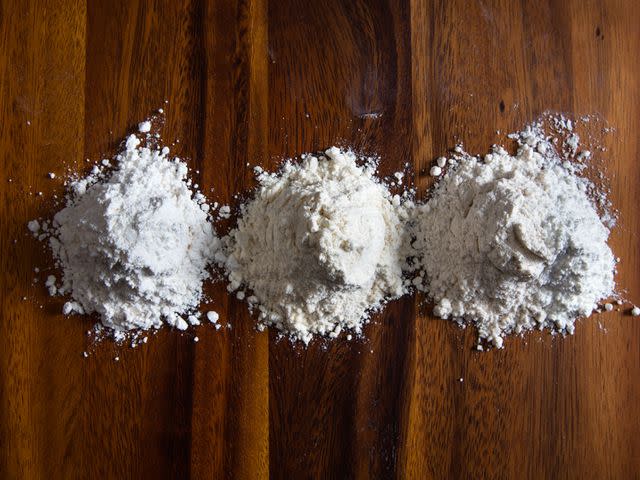
Serious Eats / Vicky Wasik
Choosing the right flour is by the far the most important decision you’ll make when it comes to how much, if any, gluten you want. In general, flours with higher protein content—more glutenin and gliadin—develop stronger and more complex gluten networks.**
That’s why you’ll find so many types of wheat flour at the supermarket labeled for a particular purpose, like bread flour, cake flour, or pastry flour. Whole wheat, durum, bread, and all-purpose flours contain between 9 and 15% protein, making them ideal for chewier foods like bread and pasta. On the lower end are pastry and cake flours with between 7 to 9% protein—perfect for tender, delicate baked goods.
**Barley and rye, although relatively high in protein, have less gluten potential because they contain molecules called pentosans. When mixed with water, pentosans absorb that water, hold onto it, and form a sticky gel that gets in the way of gluten development. Wheat also contains pentosans, but in much smaller amounts that aid in forming gluten rather than interfering with its development.
However, just because some of these flours have similar protein levels doesn’t mean they react the same way when made into a dough. Other factors are in play: The presence or absence of the grain’s germ and bran can impact gluten development. Sharp, fibrous bran particles, which you’ll find in whole wheat flours, cut through gluten strands as they form, contributing to denser dough and denser bread.
Amount of Water
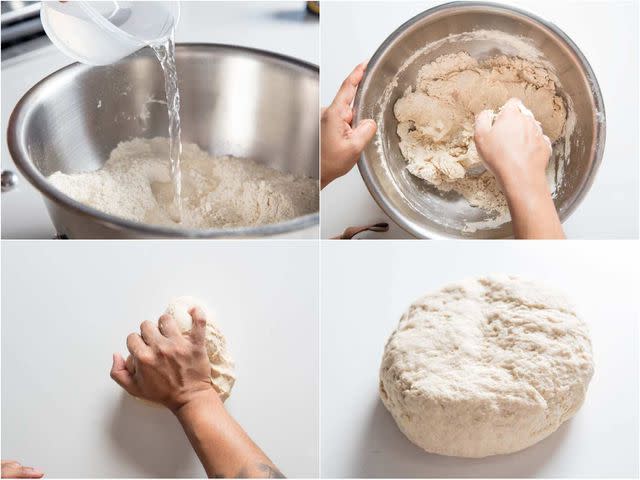
Serious Eats / Vicky Wasik
Gluten can’t form unless water is added to flour, so water—or any water-based liquid—is just as important as flour in doughs and batters. The more water that’s added, the more hydrated the flour will be, and the faster the flour’s proteins—glutenin and gliadin—can be untangled and straightened out in preparation for gluten formation.
Water content also affects dough’s initial texture. Drier doughs are firm and less extensible; wet doughs tend to be softer and sticky.
If you're a seasoned baker, you're probably familiar with terms like "hydration levels" and "bakers' percentage," which are formulas that start with the weight of the flour and add water as a percentage of that weight. A dough containing 1,000 grams of bread flour and 700 mL of water has 70% hydration, for example. Bakers often use these ratios to scale a recipe up or down, or to help alter the course or level of gluten development.
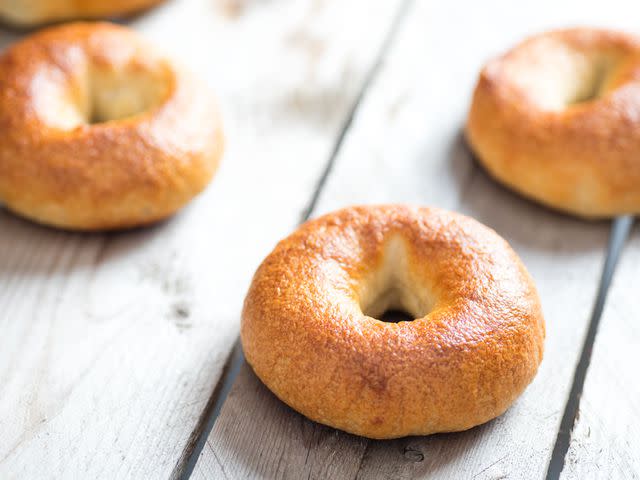
Serious Eats / Vicky Wasik
Low-hydration doughs—roughly 60% or less—like those used to make bagels and ramen noodles, are initially stiff, and produce chewier foods.
Doughs with hydration levels between 60 and 70% include Neapolitan-style pizza, pasta, and most breads (including baguettes and country breads). Our go-to country loaf has a hydration of 70%, for example, and starts out as a softer dough, but bakes into a crusty loaf with a chewy and textured interior.
Focaccia and ciabatta tend to be high-hydration breads, with levels of 70% or more. All that water contributes to a diluted gluten network, and produces a softer, moister bread with an open—airy and full of large pockets—crumb.
Regardless of how much water is added, once a dough is formed, it must be mixed, kneaded, or otherwise manipulated in order to weave the now-developed gluten strands into a strong "sheet."
Developing Gluten With Mixing, Kneading, and Other Manipulation
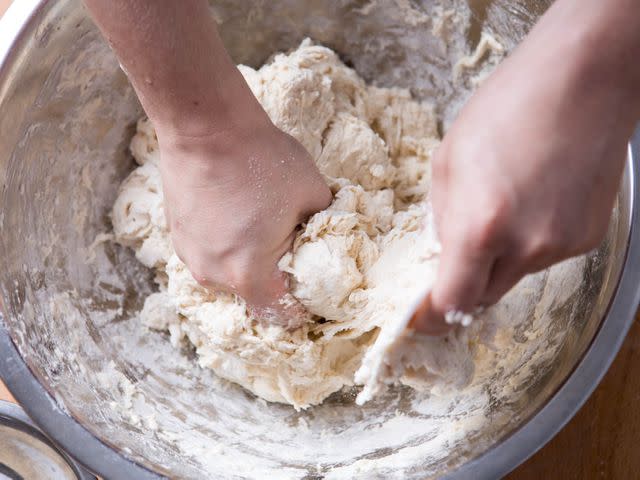
Serious Eats / Vicky Wasik
Any manual working of dough, whether it’s mixing, kneading, or folding, develops, or helps "sew" together that gluten "sheet." But, as we discussed earlier, sometimes a baker may want to encourage gluten development, and sometimes they might want to inhibit it. Fortunately, it’s easy to remember what manual manipulation does to gluten development: The more any dough or batter is mixed or kneaded, the stronger its gluten network gets.
To make tender muffins, pancakes, or waffles, it’s important to use a light touch when mixing. For crusty baguettes or chewy pizza, the opposite is true.
In the first stage of mixing flour and water together, gluten forms, but it’s mixed up—messy, or "kinky," writes Madeleine Kamman in The New Making of a Cook: The Art, Techniques, and Science of Good Cooking. For bread or noodle doughs, as you start to knead, you’re "throwing the molecules of gluten into a tizzy of stress," she writes, but inside the dough, "parallel lines have aligned themselves into... microscopic long particles of fully developed gluten." Though these bonds are not visible to the naked eye, it is possible to see what bakers call "gluten strands," which is proof of gluten development.
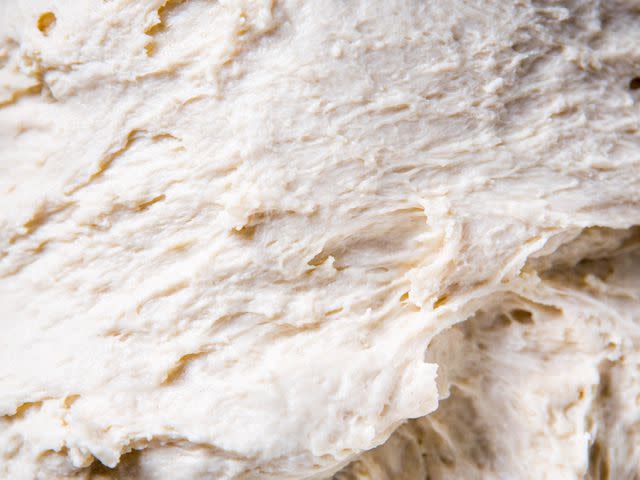
Serious Eats / Vicky Wasik
As Max explained in his breadmaking series, the more we knead, the more developed and organized the gluten becomes, and the stiffer and tighter the dough becomes. (Using an electric mixer or food processor to mix and knead a dough develops gluten faster than hand mixing.)
High-hydration bread and noodle doughs are typically kneaded extensively to ensure they develop a strong gluten network to achieve and maintain their desired texture and shape before and after cooking. Our skillet focaccia, for example, with 80% hydration, initially produces a tacky dough. But the process of mixing and subsequent folding of the dough onto itself helps incorporate air while also strengthening the gluten network to maintain its shape.
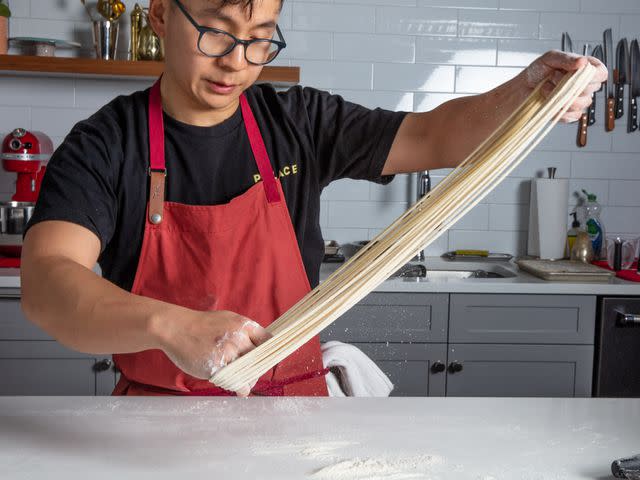
Serious Eats / Vicky Wasik
Similarly, our recipe for lamian noodles prescribes a hydration of between 62 and 68%, but because the dough is kneaded, twisted, twirled, and stretched, sufficient gluten develops to create ideal levels of elasticity and extensibility.
One exception to this is no-knead bread, for which you simply combine flour, water, salt, and yeast and let the mixture sit for anywhere from 12 to 24 hours at room temperature. Though we call it "no-knead," there’s actually plenty of kneading going on—it's just happening on a microscopic level. As the yeast eats and digests sugars, it produces carbon dioxide that is captured in bubbles, effectively agitating and manipulating the protein molecules into an organized gluten web.
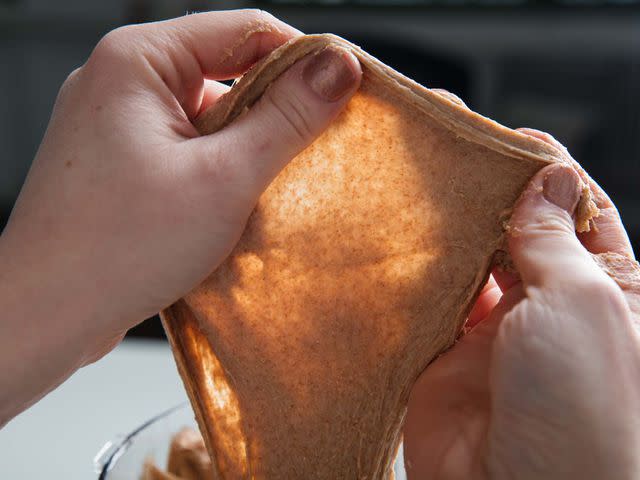
Serious Eats / Vicky Wasik
Many bakers use what’s called the windowpane test to check for gluten development. It’s a simple exercise, in which you use your hands to pull a piece of dough up out of the mass with your fingers, stretching it gently, but taut. "A well-developed dough can be stretched so thin that it’s translucent," Francisco Migoya, the author of Modernist Bread, writes. "Gluten strands tighten and reorganize once again as the dough is divided and shaped. The tension created during shaping helps the dough expand at a steady rate, producing uniform loaves."
But take note that overmixing can happen. Aggressive, sustained kneading over an extended period of time can weaken and tear the gluten network. This can be desirable, as it was for Tim's hand-pulled lamian noodles. One of his test doughs had low elasticity and high extensibility, albeit after two hours of kneading in a KitchenAid stand mixer.
Overmixing is never good for bread, though. Kamman describes overworked bread dough as "stickier, almost sweaty," at first. Then, "instead of remaining elastic, the dough... will become incredibly stretchable, as the glutenin and gliadin molecules lose their ability to crosslink." At this point, the gluten loses its shape, as does the dough, which, when baked, does not retain its rise, and suffers from poor volume and a coarse crumb. For more information on this and other common baking errors, you can check out our guide to troubleshooting bad bread.
The Impact of Temperature and Other Ingredients on Gluten
The only time temperature is a factor in gluten development is when a project also involves biological (such as yeast) fermentation. Cool temperatures slow down the fermentation process, which lets gluten strand formation "catch-up." Warmer temperatures accelerate it, forcing the gluten network to work harder, faster.
Picture this: Your bread dough is chugging along and the gluten web is doing what it should be doing, trapping gas bubbles and forming air pockets. On a cool fall day, this would be a cinch. But let’s say it’s a hot summer day and the temperature in your kitchen is hovering around 82°F (28°C). That higher room temperature accelerates fermentation, and as the yeast rapidly converts sugars into carbon dioxide, gas bubbles form and expand faster than the gluten web can accommodate. The resulting network of gluten will be stressed and imperfect, since it was never given the chance to become strong enough to trap all the gas that was produced.
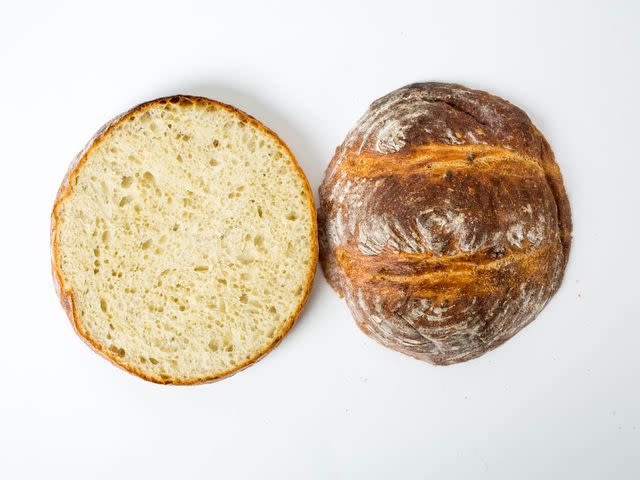
Serious Eats / Vicky Wasik
If the carbon dioxide exerts more pressure than your dough can handle, it can even tear the air pockets, releasing all that trapped gas and deflating the dough. The resulting dough is referred to as overproofed, and won’t expand much during baking due to a weakened or broken gluten structure.
Hot temperatures are what harden gluten networks in place in all types of doughs. The structure you worked diligently to develop—mixing flour with water and kneading or resting the resulting dough—is set in place once the dough is boiled into noodles or baked into bread.
Noodle dough, which is boiled, sets after a sustained period of cooking at 212°F (100°C). When it’s cooked, noodles or pasta absorb water, swell, soften, and release some of their surface starch into the water. Gluten gives al dente pasta its signature bite. That texture occurs when "hot water has penetrated to the center of the noodle, but the starch granules there have absorbed relatively little, and the starch-gluten matrix remains firm," McGee explains.
In the case of bread, the setting process starts when the interior dough of a loaf reaches 155-180°F (68-82°C). As dough bakes, the carbon dioxide and water vapor trapped in the network expand as the starches in the flour continue to gelatinize, or absorb water and swell, until their cellular walls can’t stretch any further. As the center of a loaf of bread cruises past 212°F, the boiling point of water, the starches in the flour start to dry out. This becomes the crumb, and we have the gluten network to thank for ensuring it ends up full of nooks and crannies or dense and chewy or soft and squishy.
Salt
In the dough world, salt provides more than just flavor—it strengthens gluten. Left to their own devices, glutenin proteins will naturally repel one another. According to McGee, introducing salt at a ratio of 1.5 to 2% of the flour by weight, actually encourages them to bond. When developing his recipe for hand-pulled lamian noodles, Tim Chin tested doughs with and without salt to see if it had an appreciable effect on the structure and texture of the noodle dough. Doughs made without salt were slack, sticky, and difficult to work with. Adding salt to the equation resulted in elastic doughs that were easier to handle and pull into thin noodles.
Sometimes, you don’t want to strengthen gluten, though, and ingredients that the baking world calls "tenderizers" can help.
Tenderizers
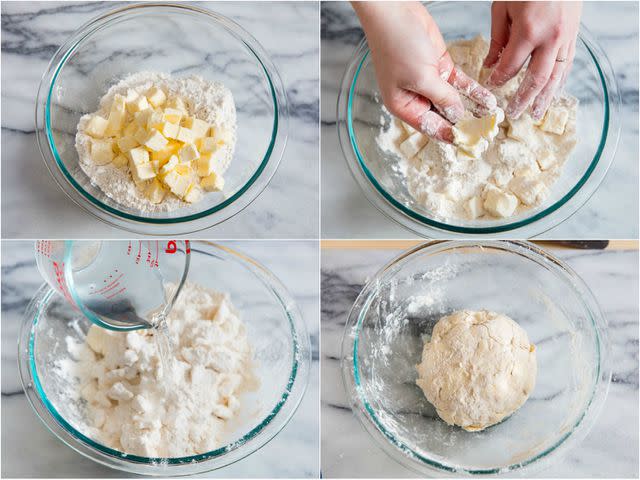
Serious Eats / Vicky Wasik
Up to this point, we’ve focused on doughs composed mainly of flour and water. But many doughs and batters contain ingredients that can inhibit or limit gluten development and encourage soft or tender textures. Appropriately, they’re called tenderizers.
Sugar appears in small quantities in many bread recipes because it can jump-start yeasty fermentation action. But in larger quantities, it’s considered a tenderizer. It works by attaching to water molecules before they can bind with glutenin and gliadin proteins, interrupting proper hydration of the flour and initially delaying the development of gluten. This contributes to a tender and moist dough, like brioche, even after it’s kneaded to develop some gluten structure.
Fats like butter, egg yolks, oil, or milk, "tenderize" doughs like brioche, challah, and babka because they limit gluten development by coating glutenin and gliadin proteins. Once coated with fat, the proteins have a harder time bonding, and form shorter gluten chains. Once baked, the resulting breads have softer crusts and plush crumbs.
Similarly, fat helps flaky doughs that don’t contain yeast, like pie crust and scones, stay tender. "Added to the flour before the water goes in, [fat] coats the flour granules, essentially waterproofing the starch so that when the water is added and the dough is worked, those gluten strands have a much harder time developing," Russ Parsons writes, in How to Read a French Fry.
Some pasta and noodle doughs contain egg yolks or oil, which can keep those shapes and strands softer despite a lot of kneading. As Niki found in her fresh pasta deep-dive, an all-yolk pasta dough produced "silkier" noodles, while pasta dough made with too much oil resulted in "softer, mushier, less elastic noodles."
So, while fat can tenderize a dough, it can also inhibit gluten development too much, and kneading may or may not help develop or maintain a good gluten network. To better control for all of these factors, professionals sometimes use chemical tricks. Though we don’t recommend them, it’s worth knowing what they can do.
Dough Conditioners
Dough conditioners are considered the jack-of-all-trades in the world of large-scale commercial bakeries. They’re primarily used to strengthen gluten networks, enhance bread crumb structure, and extend the shelf life of many types of doughs and baked goods.*** But they aren’t readily available to home cooks—and truly aren’t necessary for most home cooking projects.
***Most dough conditioners contain a mix of emulsifiers (which increase water absorption and gluten strength), salts and acids (for optimizing gluten development), maturing agents (that strengthen or weaken gluten), enzymes (to boost browning and delay staling), and additives that improve fermentation.
The latest bread-baking craze has offered us an opportunity to take a closer look at gluten’s inner workings, and you’re now equipped with a wide range of gluten intel—from what it is to the various factors that increase or limit its development. There’s a seemingly endless amount of research on gluten, and how it affects doughs of all kinds, thanks to science-minded cooks like Kamman, McGee, and Migoya at Modernist Cuisine, whose Modernist Bread books are worth a long look if you want to dive deeper into how our pals glutenin and gliadin work their magic.
May 2020

